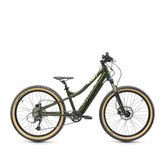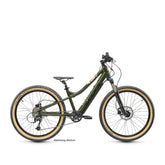Which circuit is optimal for my child?
Especially for the very little ones, when buying a bike you are faced with the question: gear shifting - yes or no? And if so, which one is best for my child? We present the different switching variants and highlight their advantages and disadvantages.
Get going?
A gear shift is a good thing in and of itself. For very young children, however, the question arises as to whether this is actually necessary. The task of a gear shift is to adapt the pedal rotation as best as possible to the respective section of the route. In other words, to ease the pedaling resistance on an incline and, in turn, to increase it on a flat route. This saves energy and makes driving much more efficient.
However, in order for a circuit to be used sensibly, a certain understanding of its functionality and handling is required. The smallest bicycle inch size is 12 inches and is suitable for children aged around 2-3 years, the 14-inch version for children aged around 4-5 years.
Since children of this age usually still have problems with operation and are overwhelmed with the coordination of driving and shifting, bikes up to 14 inches are usually not equipped with shifting systems.
As a rule of thumb, one can say that gear shifting becomes interesting when the child is so confident on the bike that they can safely operate a gear in addition to pedaling and steering.
Not all circuits are the same
When it comes to bicycles, you are spoiled for choice between chain, hub and bottom bracket gears. They differ in terms of their suitability for everyday use, susceptibility to defects, maintenance requirements, durability and service life. With derailleur gears, the bicycle chain is moved from one chainring to the next. It consists of several gears, also called pinions. Due to their open design, derailleur gears are quite susceptible to dirt and weather. Hub gears, on the other hand, have a holistically closed basic structure. The rear derailleur is reliably protected from external influences, thereby drastically reducing maintenance costs. The gearbox of bottom bracket gears is, as the name suggests, located on the bottom bracket. Due to their special design, they are very heavy and are therefore very rarely installed. For this reason, we want to leave it at the mention for the sake of completeness, but will not go into this form any further.
Advantages and disadvantages of the derailleur
Derailleur derailleurs are the classic among manual transmissions - they have been in use in their first form since 1889. They are relatively inexpensive, have a low weight and allow for many gears - up to 30 are possible. This promotes driving pleasure and enables comparatively high speeds.
In contrast, there is a high susceptibility to wear and the high effort required for maintenance and care. Since the individual components of the derailleur transmission are relatively poorly protected from external influences, the chain and mechanics must be maintained carefully and, above all, regularly. In addition, a certain level of sensitivity is required when operating it, as shifting is only possible when pedaling.
Advantages and disadvantages of hub gears
Compared to a derailleur gear, operating a hub gear is child's play. Even the littlest ones are able to implement the principle in no time. To operate the rear derailleur, pedaling is stopped while the shift lever is operated. This will then be recorded again.
Hub gears are significantly easier to care for and require less maintenance than derailleur derailleurs. This is particularly advantageous for children who use their bike every day but do not necessarily prioritize maintaining it.
However, hub gears have a smaller number of gears compared to derailleur gears, are significantly heavier and usually significantly more expensive than derailleur gears.
Our conclusion
In our opinion, changing gears only makes sense if your child has safe driving habits. They should be able to brake safely, have good fine motor skills and have a rough understanding of cause and effect. Since derailleur gears allow for a higher number of gears, but are more susceptible to wear and defects than average and require a lot of maintenance, they are not recommended for smaller children. We therefore recommend hub gears for younger children as they are easy to use and require less maintenance.
Basically you can say: the older the child, the better they get along with circuits.




